For many, the garden, patio, and backyard are places where families and friends gather to enjoy fresh air, share stories, and admire nature’s beauty.
That’s why landscape projects are some of the most common tasks that homeowners and landscape professionals undertake. From cozy and intimate gardens to expansive, open-concept lawns, all successful landscape projects begin the same way — with a well-planned landscape design and layout.
So let’s explore a variety of landscape styles and smart design ideas that’ll spark your creativity. In this 10-minute read, we’ll cover all you need to know — from the basic principles of landscape design to overcoming common challenges.
Let’s start with some of the top landscape styles and design ideas.
Common Landscape Styles & Design Ideas
As you start collaborating with your client on their landscape project, it’s important to help them choose a landscape style. Here are some of the most common landscape styles and design ideas.
Traditional Landscape Design
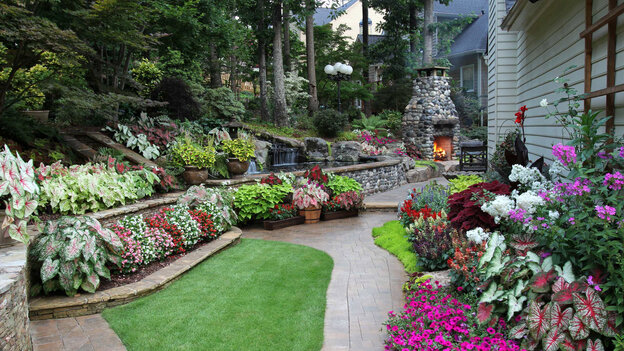
Picture a garden where every plant, path, and piece of decor sits just where it should. Think manicured lawns, neatly trimmed hedges, and orderly plantings. Color palettes are refined and understated. Each element is meticulously placed to create a balanced, cohesive look.
Tip: Use symmetrical layouts, antique or rustic decorations, and classic flowers and shrubs to capture this evergreen style!
Modern Landscape Architecture

A modern landscape design creates a space where simplicity and sophistication meet. Picture sleek lines, uncluttered spaces, and a focus on functionality. The color palette is often neutral, letting the architectural elements and carefully chosen plant life take center stage.
Tip: Stick to a neutral palette, incorporate modern materials like metal and glass, and don’t be afraid to play with geometric shapes and patterns!
Xeriscaping for Water Conservation
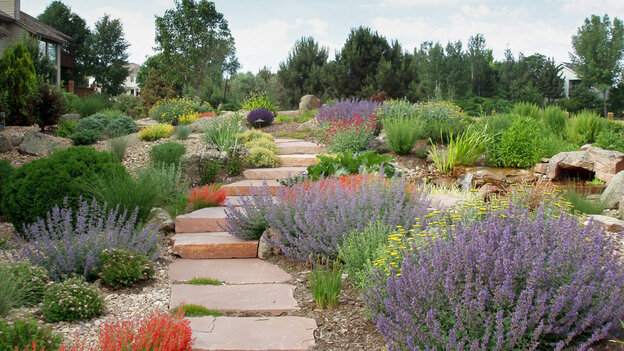
Xeriscaping is a smart, sustainable approach to landscape design that is tailored for areas prone to drought. Traditional lawns? They’re swapped out for artistic sweeps of gravel and stones. By selecting native plants, incorporating gravel or mulch, and strategically placing hardscape features, you can create visually appealing and sustainable landscapes that thrive in dry conditions.
Tip: Focus on native and drought-resistant plants. Go with gravel and stones to reduce the need for water!
Coastal Landscape Style
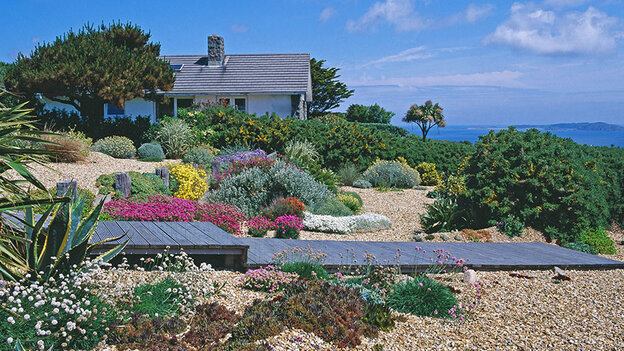
The coastal landscape style is characterized by light, airy designs. There’s a focus on native, salt-tolerant plants that thrive in the unique coastal environment. Sandy paths mimic the beach. Hues of blue and green echo the ocean and sky. This combination creates a casual elegance that promotes relaxation while celebrating the beauty of the seashore.
Tip: Opt for plants that can handle a bit of salt in the air. Also, choose colors and decorations that echo the serenity of the seaside!
Help Your Client Pick a Theme
It’s essential to understand your client’s style preferences — whether they’re leaning towards a sleek, modern aesthetic or a lush, natural haven. Keep in mind factors such as:
- The local environment
- Climate and soil type
- Budget
- Maintenance
- Site Analysis
PRO TIP! – For easier communication with clients use 3D design software like Cedreo. It turns abstract ideas into tangible visuals. This promotes better feedback since clients can visualize the final result.
The Basic Principles of Landscape Design
Here are the core principles that bring landscape design to life.
Balance and Symmetry
Balance and symmetry play a crucial role in creating harmonious landscape designs. There are two types of balance — symmetrical and asymmetrical.
Symmetrical balance involves creating identical or mirrored elements on either side of a central point This results in a sense of formality and order. Asymmetrical balance, on the other hand, involves arranging diverse elements in a way that visual weight is evenly distributed without being identical. Both types can be used to create visually pleasing and balanced landscapes.
Symmetrical Balance In Action: Imagine a sidewalk lined with matching shrubs on either side.
Focal Points
Focal points are essential elements that draw attention and create a sense of interest in a landscape. Whether it’s a striking sculpture, a water feature, or a well-designed seating area, focal points provide a visual anchor and guide the viewer’s gaze.
To create effective focal points, consider factors such as scale, contrast, and placement within the landscape. By emphasizing and highlighting these central elements, you can enhance the overall aesthetic appeal of the outdoor space.
A Focal Point In Action: Imagine a serene garden with a sunken conversation pit and a massive fire ring as the focal point.
Scale and Proportion
Scale and proportion refer to the relationship between various elements within a landscape. It’s important to consider the size, height, and mass of plants, structures, and hardscape features in relation to the overall space. Ensuring that these elements are properly scaled and proportioned will create a pleasing visual balance. This helps prevent overcrowding or disproportionate arrangements that can detract from the overall design.
Scale and Proportion In Action: Ensure the focal point of a small garden isn’t dwarfed by larger features or plants.
Color Theory in Landscaping
Colors can significantly impact the mood and visual appeal of a landscape. Warm colors such as red, orange, and yellow create a vibrant and energetic atmosphere. Cool colors like blue, green, and purple evoke a sense of calm and tranquility. So think about how to use color combinations, contrasts, and the strategic placement of plants and flowers to create visually dynamic landscapes.
Color Theory In Action: In a sun-filled garden, blending cool-toned plants like lavender and blue hydrangeas with warm-toned marigolds creates a vibrant and harmonious color palette.
Keep going to dive into the important topic of pricing your landscape design services.
How Much Should You Charge for Landscape Design?
Determining the appropriate pricing for your landscape design services is essential for the success of your business. Here are some key considerations and strategies to help you calculate project costs and set prices that align with the value you provide.
Estimating Project Costs: A Step-by-Step Guide
Estimating project costs involves a systematic approach to ensure accuracy and fairness. Here are the main steps for determining the costs involved in your landscape design projects:
- Assess the scope of work: Break down the project into individual elements or tasks, such as site analysis, concept development, plant selection, hardscape installation, and project management.
- Calculate time and labor: Estimate the amount of time required for each task and the number of team members involved. Consider factors such as site conditions, complexity, and team experience.
- Material and equipment costs: Research and estimate the costs of plants, materials, and equipment needed for the project. Consider factors such as quantity, quality, and any special requirements.
- Overhead expenses: Account for overhead expenses such as office rent, utilities, insurance, and marketing costs. Be sure to allocate a portion of these expenses to each project.
- Profit margin: Add a profit margin to account for your expertise, creativity, and business growth. This margin should reflect the value you bring to the client.
Hourly Rates vs Fixed Prices: Pros and Cons
A question a lot of new landscape professionals ask is… should I charge by the hour or charge a fixed price (such as a fixed amount per type of project or per square foot)? Here are some of the pros and cons of each.
Hourly Rates:
- Pros: Provide flexibility for projects with uncertain scopes or constantly evolving requirements. Can be advantageous for clients with smaller budgets.
- Cons: This may create uncertainty for clients who prefer fixed-price options. This can lead to disputes over hours worked and potential scope creep.
Fixed Prices:
- Pros: Offer clarity and predictability to clients. Allows for better financial planning for clients and designers. Reduces administrative tasks related to time tracking and billing.
- Cons: Can be challenging to accurately estimate project costs which can lead to potential profit loss if underestimated. May not accommodate significant changes in project scope.
Common Landscape Design Challenges
Landscape designers often face obstacles related to space limitations, climate and weather conditions, budget constraints, and managing client expectations. Here are some tips from the pros to help you overcome these common challenges:
Space Limitations
Designing for small or limited outdoor spaces requires creativity and efficient planning. Here are some ideas for maximizing the potential of small areas:
- Vertical gardening: Utilize vertical space by incorporating hanging plants, trellises, and living walls. This adds greenery and also creates visual interest while maximizing available space.
- Multi-functional elements: Incorporate design elements that serve multiple purposes, like seating that also provides storage. Or use planters as dividers to create separate areas in small gardens.
- Optimize planting choices: Select plants that are well-suited to small spaces, such as compact or dwarf varieties. Container gardening is also a smart choice since you can easily move and reconfigure plants as needed.
- Strategic lighting: Use lighting to create the illusion of more space and draw attention to specific areas. Proper lighting can visually expand small outdoor areas and make them feel more inviting.
Climate and Weather Issues
Here are some strategies to address climate and weather challenges:
- Research local climate: Understand the specific climate patterns in your area, including temperature ranges, precipitation levels, and wind conditions.
- Drought-tolerant landscaping: Incorporate drought-tolerant plants and xeriscaping techniques to minimize water usage. Mulching and proper irrigation systems can also help conserve water.
- Wind-resistant features: Design windbreaks using hedges, walls, or trellises to shield the landscape from strong winds.
- Shade and sun considerations: Take advantage of natural shade from trees and structures to create comfortable outdoor spaces. On the other hand, make sure plants that require plenty of sun won’t be shaded.
Budget Constraints
Working within a budget is challenging. Here are some ways to overcome budget limitations:
- Prioritize essential elements: Identify the most critical aspects of the design that align with your client’s goals and budget. Then allocate more resources to these focal points while finding cost-saving alternatives for less important features.
- Value engineering: Find creative solutions to achieve the desired outcome while reducing costs. This may include using less expensive materials that still provide a similar aesthetic or designing in phases to spread out expenses.
- Communication and transparency: From the very beginning, establish open communication with clients regarding budget constraints. Be upfront about potential cost implications and offer alternative suggestions to meet their needs within their budget.
- Long-term planning: Most don’t realize that over time, maintenance costs are often more than the initial cost of the project. So recommend durable materials and low-maintenance landscapes that will save clients money in the long term.
Client Expectations: Balancing Creativity and Client Desires
Managing client expectations can be a delicate balancing act for any housing professional. Check out these tips for ensuring creativity while meeting client desires:
- Establish a clear brief: Begin the design process by thoroughly understanding your client’s vision, preferences, and desired outcomes. Document these details to ensure you’re on the same page.
- Present design concepts: Develop multiple design concepts that showcase your creative ideas. Present them to clients and encourage their feedback. Try to allow for a collaborative approach that merges your expertise with their preferences.
- Educate clients: Guide clients through the design process. Don’t be afraid to explain the reasons behind your design suggestions. Educate them on any challenges and help them understand the limitations and possibilities.
- Communication throughout the process: Maintain regular communication to update clients on the progress of the design and construction. Address any concerns promptly and provide clarity on timelines and expectations.
PRO TIP! – Instead of relying solely on verbal explanations and your client’s imagination, use 3D visuals to showcase your ideas. This is a huge help in avoiding miscommunications during the planning stage. The easiest way to get professional 3D images is with Cedreo’s landscape planner.
Speaking of software, keep going in the next section for tips on choosing the best landscape design software.
Best Software for Landscape Design
Cedreo
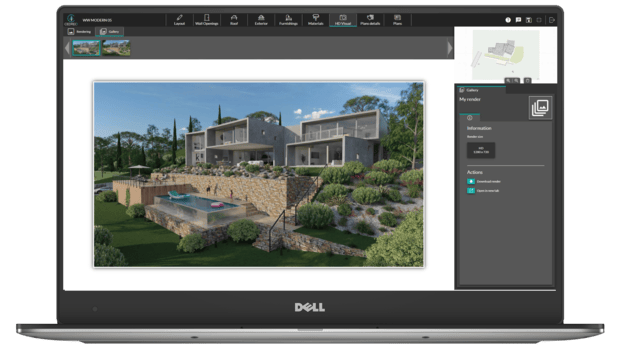
Cedreo stands out as an excellent option for users who want a hassle-free and user-friendly program with professional-quality results. Here are some key features of Cedreo:
Pros:
- Intuitive interface that is easy to navigate even for beginners
- Save loads of time by creating landscape plans in minutes, not days
- Powerful 3D landscape architecture rendering capabilities that create stunning visualizations
- Extensive library of pre-designed elements, including plants, materials, and outdoor furniture
- Easy customization and modifications to adapt designs to specific client requirements
- Industry-leading customer support that gets you the help you need when you need it
Cons:
- Some advanced customization options may be lacking for more complex projects
Cedreo’s got a version you can try for FREE. Sign up today!
SmartDraw
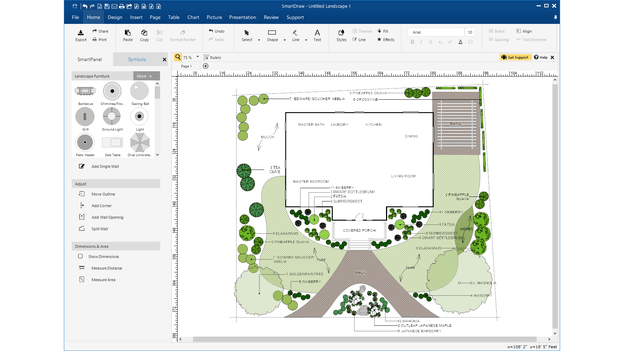
SmartDraw is another popular software choice for landscape design. SmartDraw is a versatile diagramming software that offers various templates and tools to create detailed landscape designs.
Pros:
- Templates and designs tailored specifically for landscape design
- Drag-and-drop interface for creating professional-looking diagrams
- Integration with other tools like AutoCAD
- Symbol library for adding plants, hardscapes, and other design elements
Cons:
- Lacks advanced 3D rendering capabilities compared to dedicated 3D modeling software
- Limited customization options for certain design elements
SketchUp

SketchUp is a highly versatile 3D modeling software used in various design industries, including landscape design. It is a powerful software that helps users create intricate 3D models and visualize their designs from different perspectives.
Pros:
- Robust 3D modeling capabilities
- A vast library of 3D models and components available for download
- Extensive rendering options for creating impressive visualizations with the help of additional plug-ins
- Integration with other design software
Cons:
- Steep learning curve if you don’t have a lot of 3D experience
- Some features require additional plugins or extensions which cost extra
Ideas for Remarkable Landscape Designs
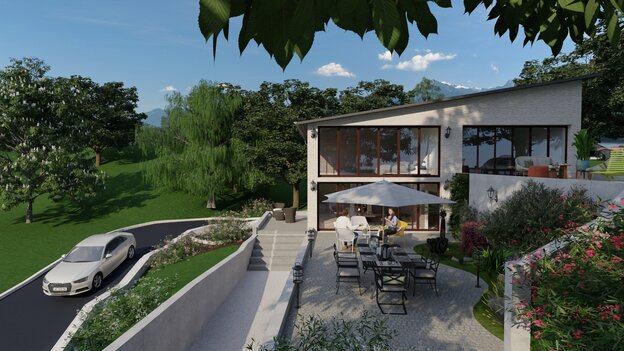
Check out these 7 landscape design ideas to help spark your creativity.
Incorporate Water Features
Ponds, fountains, waterfalls, and reflecting pools can add tranquility and visual interest to any landscape design.
Sustainable Landscaping
Opt for eco-friendly choices such as rainwater harvesting, native plants, permeable paving, and efficient irrigation systems.
Outdoor Living Spaces
Design functional and comfortable areas like outdoor kitchens, fire pits/fireplaces, covered seating areas, decks, and pergolas.
Use Native Plants
Enhance aesthetics with local flora that is well-adapted to the climate and supports local wildlife.
Create an Outdoor Conversation Pit
Build a sunken seating area with a fire pit and surround it with landscaping for a cozy gathering space.
Incorporate Vertical Gardens
Add visual interest and maximize limited space by incorporating vertical gardens. Use things like hanging planters, trellises, and living walls.
Introduce Art and Sculptures
Enhance the visual appeal of your landscape design by incorporating art and sculptures that complement the surrounding environment.
Conclusion
Ready to turn your landscape ideas into reality for your next project? Why not use the power of Cedreo software to simplify your design process?
Discover the benefits of Cedreo home design software:
- Extensive Design Library: Access thousands of plants, shrubs, trees, and customizable hardscape elements to bring variety and creativity to your designs.
- 3D Visualization: Breathe life into your designs with stunning 3D renderings that help you showcase the final look and feel of your landscapes.
- User-Friendly Interface: Streamline your workflow with intelligent tools that handle complex tasks to make your design process more efficient and enjoyable.
- Team Collaboration: With cloud software, you and your team can access designs from anywhere, promoting seamless communication and collaboration.
Sign up for Cedreo today (there’s a FREE version to try risk-free) and unlock a world of possibilities for your landscape design projects.



